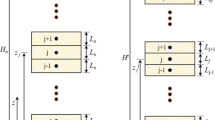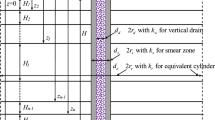Abstract
How to predict the long-term deformation of natural soft soils under embankments has been an important yet challenging issue in geotechnical and transportation engineering. The major difficulties lie in consolidation analyses of thick soil layers, modelling of the nonlinear time-dependent stress–strain behaviour of clayey soils, and proper determination of soil parameters. While finite element (FE) software has great advantages and wide applications in consolidation analyses, development of reliable simple methods, which can be conveniently used by engineers, is also needed. In this paper, both a fully coupled FE model and a simplified Hypothesis B method are developed and applied for long-term deformation analyses of two test embankments on the multi-layered Malaysian marine clays. FE simulations are conducted using PLAXIS with a nonlinear 3-D elastic visco-plastic (3-D EVP) model. A series of parametric studies are carried out on the influences of soil parameters and modelling techniques using this FE model. A simplified Hypothesis B method with the nonlinear 1-D EVP model and modifications for 2-D stress diffusion and buoyancy effects is derived and applied for estimating the long-term consolidation settlement curves of the two test embankments. It is found that the fully coupled FE model with the nonlinear 3-D EVP can simulate the long-term embankment displacements with good agreement with measured data. Parametric studies indicate that using averaged soil indices and updating static pore pressure have significant contributions to the accuracy of simulations. The settlements calculated by the improved simplified Hypothesis B method are found in close agreement with FE simulation results and measured data.
















Similar content being viewed by others
References
Adachi T, Oka F (1982) Constitutive equations for normally consolidated clay based on elasto-viscoplasticity. Soils Found 22(4):57–70
Balasubramaniam AS, Huang M, Bolton M, Oh EYN, Bergado DT, Phienwej N (2007) Interpretation and analysis of test embankments in soft clays with and without ground improvement. Geotech Eng 38(3):235
Biot MA (1956) General solutions of the equations of elasticity and consolidation for a porous material. J appl Mech 23(1):91–96
Borja RI, Kavazanjian E (1985) A constitutive model for the stress–strain–time behaviour of ‘wet’ clays. Geotechnique 35(3):283–298
Brinkgreve RBJ, Broere W (2015) PLAXIS 2D reference manual 2015. Delft, Netherlands, p 2010
Chen ZJ, Feng WQ, Yin JH (2021) A new simplified method for calculating short-term and long-term consolidation settlements of multi-layered soils considering creep limit. Comput Geotech 138:104324
Chen RP, Zhou WH, Wang HZ, Chen YM (2005) One-dimensional nonlinear consolidation of multi-layered soil by differential quadrature method. Comput Geotech 32(5):358–369
Chen ZJ, Feng WQ, Yin JH (2021a) Finite element simulations of clayey soil ground with a three-dimensional nonlinear elastic viscoplastic model. In: Barla M, Di Donna A, Sterpi D (eds) Challenges and innovations in geomechanics. IACMAG 2021 lecture notes in civil engineering, vol 125, Springer, Cham. https://doi.org/10.1007/978-3-030-64514-4_34
Fatahi B, Le TM, Le MQ, Khabbaz H (2013) Soil creep effects on ground lateral deformation and pore water pressure under embankments. Geomech Geoeng 8(2):107–124
Feng W (2016) Experimental study and constitutive modelling of the time-dependent stress-strain behavior of soils. The Hong Kong Polytechnic University, Hong Kong
Feng WQ, Lalit B, Yin ZY, Yin JH (2017) Long-term non-linear creep and swelling behavior of Hong Kong marine deposits in oedometer condition. Comput Geotech 84:1–15
Feng WQ, Yin JH (2017) A new simplified Hypothesis B method for calculating consolidation settlements of double soil layers exhibiting creep. Int J Numer Anal Meth Geomech 41(6):899–917
Feng WQ, Yin JH (2018) A new simplified Hypothesis B method for calculating the consolidation settlement of ground improved by vertical drains. Int J Numer Anal Meth Geomech 42(2):295–311
Feng WQ, Yin JH, Chen WB, Tan DY, Wu PC (2020) A new simplified method for calculating consolidation settlement of multi-layer soft soils with creep under multi-stage ramp loading. Eng Geol 264:105322
Feng WQ, Li YL, Yin JH, Yin ZY (2014) The numerical implementation of elastic visco-plastic model for soft clays. Numer Method Geotech Eng, 39
Flamant M (1892) On the distribution of stresses in a two dimensional solid under transverse loading. Acad Sci Paris C R 114:1465–1468 ((in French))
Folkes DJ, Crooks JHA (1985) Effective stress paths and yielding in soft clays below embankments. Can Geotech J 22(3):357–374
Freitas TMB, Potts DM, Zdravkovic L (2011) A time dependent constitutive model for soils with isotach viscosity. Comput Geotech 38(6):809–820
Gong XN, Xie KH (2014) Soil mechanics. China Architecture & Building Press, Beijing
Graham J, Crooks JHA, Bell AL (1983) Time effects on the stress-strain behaviour of natural soft clays. Géotechnique 33(3):327–340
Grimstad G, Degago SA, Nordal S, Karstunen M (2010) Modeling creep and rate effects in structured anisotropic soft clays. Acta Geotech 5(1):69–81
Hansbo S, Jamiolkowski M, Kok L (1981) Consolidation by vertical drains. Géotechnique 31(1):45–66
Hinchberger SD, Rowe RK (1998) Modelling the rate-sensitive characteristics of the Gloucester foundation soil. Can Geotech J 35(5):769–789
Hinchberger SD, Rowe RK (2005) Evaluation of the predictive ability of two elastic-viscoplastic constitutive models. Can Geotech J 42(6):1675–1694
Kelln C, Sharma J, Hughes D, Graham J (2008) An improved elastic–viscoplastic soil model. Can Geotech J 45(10):1356–1376
Kutter BL, Sathialingam N (1992) Elastic-viscoplastic modelling of the rate-dependent behaviour of clays. Géotechnique 42(3):427–441
Ladd CC, Foott R, Ishihara K, Schlosser F, Poulos HG (1977) Stress deformation and strength characteristics. In: International conference on soil mechanics and foundation engineering, 9th, (Vol. 2) Tokyo, Japan
Lerouel S, Kabbaj M, Tavenas F, Bouchard R (1985) Stress-strain-strain rate relation for the compressibility of sensitive natural clays compressibility. Geotechnique 35(2):159–180
Li J, Yin ZY (2020) A modified cutting-plane time integration scheme with adaptive substepping for elasto-viscoplastic models. Int J Numer Meth Eng 121(17):3955–3978
Loganathan N, Balasubramaniam AS, Bergado DT (1993) Deformation analysis of embankments. J Geotech Eng 119(8):1185–1206
Magnan J, Kattan A (1989) Additional analysis and comments on the performance of Muar Flats trial embankment to failure. In: International symposium on trial embankments on Malaysian marine clays, (pp. 11–1)
Mesri G, Godlewski PM (1977) Time-and stress-compressibility interrelationship. J Geotech Eng Div 103(5):417–430
Osterberg JO (1957) Influence values for vertical stresses in a semi-infinite mass due to an embankment loading. In: Proceedings 4th international conference soil mechanics foundation engineering, 393–394
Perzyna P (1963) The constitutive equations for rate sensitive plastic materials. Q Appl Math 20(4):321–332
Poulos HG, Lee CY, Small JC (1989) Prediction of embankment performance on Malaysian marine clays. In: International symposium on trial embankments on Malaysian marine clays, (Vol. 3, pp. 22–30)
Roscoe K, Burland JB (1968) On the generalized stress-strain behaviour of wet clay. In: Heyman J, Leckie F(eds) Engineering plasticity. Cambridge University Press, Cambridge, pp 535–609
Schmertmann JH (2005) Stress diffusion experiment in sand. J Geotech Geoenviron Eng 131(1):1–10
Shi XS, Yin J, Feng W, Chen W (2018) Creep coefficient of binary sand–bentonite mixtures in oedometer testing using mixture theory. Int J Geomech 18(12):04018159
Tavenas F, Jean P, Leblond P, Leroueil S (1983) The permeability of natural soft clays Part II: permeability characteristics. Can Geotech J 20(4):645–660
Terzaghi K (1943) Theoretical soil mechanics. Wiley, New York
Vermeer PA, Neher HP (1999) A soft soil model that accounts for creep. Proc., Plaxis Symposium. Beyond 2000 in computational geotechnics. Balkema, Rotterdam, 249–261
Walker R, Indraratna B, Sivakugan N (2009) Vertical and radial consolidation analysis of multilayered soil using the spectral method. J Geotech Geoenviron Eng 135(5):657–663
Wang H, Zeng LL, Bian X, Hong ZS (2019) Evaluation of vertical superimposed stress in subsoil induced by embankment loads. Int J Geomech 19(1):04018182
Yin JH (1999) Non-linear creep of soils in oedometer tests. Geotechnique 49(5):699–707
Yin ZY, Chang CS, Karstunen M, Hicher PY (2010) An anisotropic elastic–viscoplastic model for soft clays. Int J Solids Struct 47(5):665–677
Yin JH, Feng WQ (2017) A new simplified method and its verification for calculation of consolidation settlement of a clayey soil with creep. Can Geotech J 54(3):333–347
Yin JH, Graham J (1989) Viscous–elastic–plastic modelling of one-dimensional time-dependent behaviour of clays. Can Geotech J 26(2):199–209
Yin JH, Graham J (1994) Equivalent times and one-dimensional elastic viscoplastic modelling of time-dependent stress–strain behaviour of clays. Can Geotech J 31(1):42–52
Yin JH, Graham J (1999) Elastic viscoplastic modelling of the time-dependent stress-strain behaviour of soils. Can Geotech J 36(4):736–745
Yin JH, Zhu G (2020) Consolidation analyses of soils. CRC Press, London
Yin JH, Zhu JG, Graham J (2002) A new elastic viscoplastic model for time-dependent behaviour of normally and overconsolidated clays: theory and verification. Can Geotech J 39(1):157–173
Zhou C, Yin JH, Zhu JG, Cheng CM (2005) Elastic anisotropic viscoplastic modeling of the strain-rate-dependent stress–strain behavior of K 0-consolidated natural marine clays in triaxial shear tests. Int J Geomech 5(3):218–232
Zhu G, Yin JH (2004) Consolidation analysis of soil with vertical and horizontal drainage under ramp loading considering smear effects. Geotext Geomembr 22(1–2):63–74
Acknowledgements
We are thankful for the financial support by Project from Natural Science Foundation of Guangdong Province, China (2022A1515010118), Shenzhen Science and Technology Innovation Commission (JCYJ20210324105210028). The work is supported by a Research Impact Fund (RIF) project (R5037-18), a Theme-based Research Scheme Fund (TRS) project (T22-502/18-R), and three General Research Fund (GRF) projects (PolyU 152179/18E; PolyU 152130/19E; PolyU 152100/20E) from Research Grants Council (RGC) of Hong Kong Special Administrative Region Government of China, Key Special Project for Introduced Talents Team of Southern Marine Science and Engineering Guangdong Laboratory (Guangzhou) (GML2019ZD0210), Southern Marine Science and Engineering Guangdong Laboratory (Guangzhou) (K19313901).
Author information
Authors and Affiliations
Corresponding author
Additional information
Publisher's Note
Springer Nature remains neutral with regard to jurisdictional claims in published maps and institutional affiliations.
Rights and permissions
Springer Nature or its licensor (e.g. a society or other partner) holds exclusive rights to this article under a publishing agreement with the author(s) or other rightsholder(s); author self-archiving of the accepted manuscript version of this article is solely governed by the terms of such publishing agreement and applicable law.
About this article
Cite this article
Chen, ZJ., Feng, WQ., Yin, JH. et al. Finite element model and simple method for predicting consolidation displacement of soft soils exhibiting creep underneath embankments in 2-D condition. Acta Geotech. 18, 2513–2528 (2023). https://doi.org/10.1007/s11440-022-01741-z
Received:
Accepted:
Published:
Issue Date:
DOI: https://doi.org/10.1007/s11440-022-01741-z




